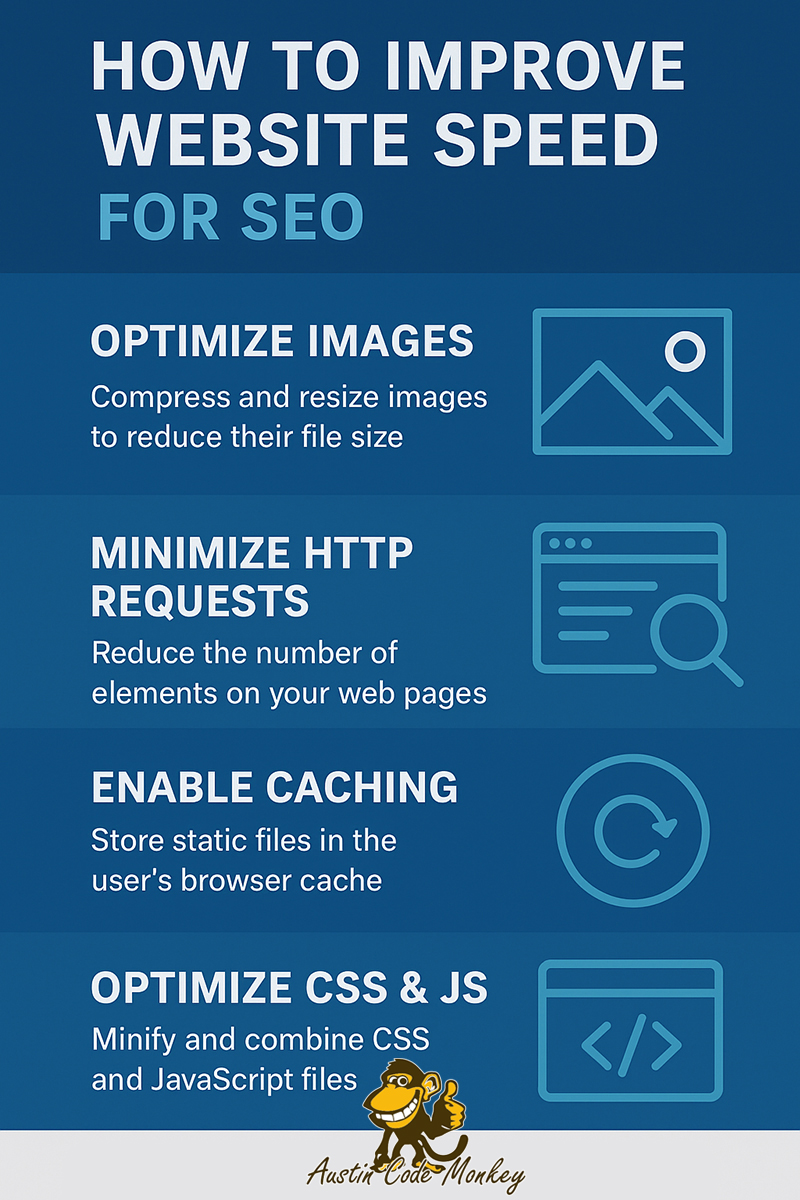Learn how to improve website speed for SEO with proven strategies. Boost rankings, reduce bounce rates, and improve user experience with this step-by-step guide.
How to Improve Website Speed for SEO: A Complete Guide
When it comes to ranking on Google, website speed is one of the most critical SEO factors. A slow-loading website not only frustrates users but also signals to search engines that your site isn’t providing the best experience.
Google has confirmed that page speed is a direct ranking factor, and it’s also part of Core Web Vitals, a set of metrics that measure real-world user experience.
In this guide, we’ll explain why website speed matters for SEO, how to test your site’s performance, and the best actionable strategies to make your site faster.
Learn how Austin Code Monkey helps businesses achieve faster, higher-ranking websites with expert SEO services. This episode highlights their approach to optimizing Core Web Vitals, caching, and more. Visit austincodemonkey.com to see how they can supercharge your website’s performance.
Why Website Speed Matters for SEO
-
Ranking Signal – Google uses speed and Core Web Vitals to rank sites.
-
User Experience – A site that loads in 2 seconds or less improves engagement and conversions.
-
Bounce Rate – 53% of users leave if a page takes longer than 3 seconds to load.
-
Mobile-First Indexing – Google evaluates the mobile version of your site, where speed is crucial.
👉 Related: Technical SEO Audit Guide for Beginners
How to Test Your Website Speed
Before you can improve speed, you need to measure it.
Recommended Tools:
-
Google PageSpeed Insights – Analyzes desktop and mobile performance.
-
GTmetrix – Provides detailed waterfall breakdowns.
-
Pingdom – Good for monitoring uptime and speed.
-
WebPageTest – Advanced metrics like time to first byte (TTFB).
👉 Related: How Search Engines Work: Crawling, Indexing, and Ranking Explained
✅ 15 Steps to Improve Website Speed for SEO
Here’s a step-by-step checklist to optimize your site’s performance.

1. Choose a Fast Web Host
Your hosting provider directly impacts server response time.
-
Use a reliable host like SiteGround, Kinsta, or WP Engine.
-
Consider upgrading to a VPS or dedicated server if traffic is high.
2. Use a Content Delivery Network (CDN)
A CDN distributes your website content across global servers.
-
Popular CDNs: Cloudflare, BunnyCDN, KeyCDN.
-
Reduces latency and improves load times worldwide.
3. Optimize Images
Large images are the #1 cause of slow websites.
-
Compress with TinyPNG, ShortPixel, or Imagify.
-
Use next-gen formats like WebP.
-
Add descriptive alt text for SEO.
👉 Related: On-Page SEO Checklist: 25 Steps to Rank Higher
4. Minify CSS, JavaScript, and HTML
Remove unnecessary spaces, comments, and characters.
-
Tools: Autoptimize, WP Rocket, or Gulp/Grunt for developers.
5. Enable Browser Caching
Store static files in a user’s browser for faster reloads.
-
Use
.htaccessrules or plugins like W3 Total Cache.
6. Reduce Redirects
Each redirect adds extra loading time.
-
Fix broken links.
-
Minimize unnecessary 301 redirects.
7. Use Lazy Loading
Load images and videos only when they enter the viewport.
-
Built into WordPress 5.5+
-
Plugins: a3 Lazy Load, WP Rocket.
8. Optimize Database Performance
Databases can slow down over time.
-
Use WP-Optimize or Advanced Database Cleaner.
-
Regularly clear out post revisions, drafts, and spam comments.
9. Implement GZIP Compression
Compresses files before sending them to the browser.
-
Check with GTmetrix if enabled.
-
Can be activated via cPanel or plugins.
10. Prioritize Critical CSS
Load only above-the-fold CSS first.
-
Tools: Critical Path CSS Generator.
-
WP Rocket has built-in critical CSS functionality.
11. Improve Server Response Time
-
Aim for TTFB < 200ms.
-
Use high-performance hosting and optimized databases.
12. Use Asynchronous Loading for JavaScript
Allows multiple scripts to load simultaneously.
-
Add
asyncordeferattributes to scripts.
13. Monitor and Fix 404 Errors
Too many 404s can slow crawling and waste resources.
-
Use Google Search Console to identify issues.
14. Optimize for Core Web Vitals
Google’s key metrics:
-
Largest Contentful Paint (LCP): < 2.5s
-
First Input Delay (FID): < 100ms
-
Cumulative Layout Shift (CLS): < 0.1
15. Regularly Audit and Monitor Speed
Website speed isn’t a one-time fix—it requires ongoing monitoring.
-
Schedule monthly checks with GTmetrix or Pingdom.
👉 Related: Why Your Website Isn’t Ranking on Google
Advanced Speed Optimization Tips
If you’ve implemented the basics, take it further:
-
Use AMP (Accelerated Mobile Pages) for blogs.
-
Implement HTTP/3 if supported.
-
Use prefetching and preloading for resources.
-
Monitor third-party scripts (chatbots, ads, widgets) and remove what isn’t essential.
Internal Linking Strategy & Anchor Texts
This article is a supporting pillar in your SEO hub.
Parent Pillar:
Related Supporting Pillars:
Recommended Anchor Texts:
-
“how to improve website speed for SEO” → this blog
-
“technical SEO audit” → link to audit guide
-
“on-page SEO checklist” → link to checklist
-
“why your website isn’t ranking” → link to ranking issues post
-
“SEO vs Google Ads” → link to comparison post
This creates a pillar-cluster structure to maximize internal linking strength.
Austin Code Monkey’s SEO Services
At Austin Code Monkey, we don’t just build websites—we make them fast, optimized, and built to rank.
Our SEO services include:
-
Full technical SEO audits (speed, indexing, Core Web Vitals).
-
On-page SEO for higher rankings.
-
Custom web development optimized for speed.
-
Local SEO strategies for Austin-based businesses.
-
Google Ads management to complement organic SEO.
If your website is slow, you’re losing rankings, traffic, and revenue. Let us help you fix it.
👉 Explore Austin Code Monkey’s SEO Services and start improving your website speed today.
👉 Related reading: How to Local SEO in 2025? A Beginner’s Guide to Search Engine Optimization
Conclusion
Improving website speed isn’t just about technical performance—it’s about creating a better user experience, reducing bounce rates, and increasing your chances of ranking higher on Google.
By following this 15-step guide, you’ll build a faster site that performs better in search results and converts more visitors.
And if you want expert help, Austin Code Monkey is here to provide website speed optimization and SEO services that get measurable results.
Austin Code Monkey Delivers SEO Services in Austin, TX
Austin Code Monkey offers tailored SEO services for businesses in Austin, Texas, specializing in On-Page, Off-Page, and Technical SEO to boost online visibility. Their expert team focuses on ethical White Hat strategies, including keyword research, content optimization, and link building, to drive sustainable growth. Visit austincodemonkey.com to discover how their customized solutions can elevate your business in search engine rankings and attract more traffic.
Contact Austin Code Monkey For
Local and Nationwide On-Page SEO Services at 737-932-7532

